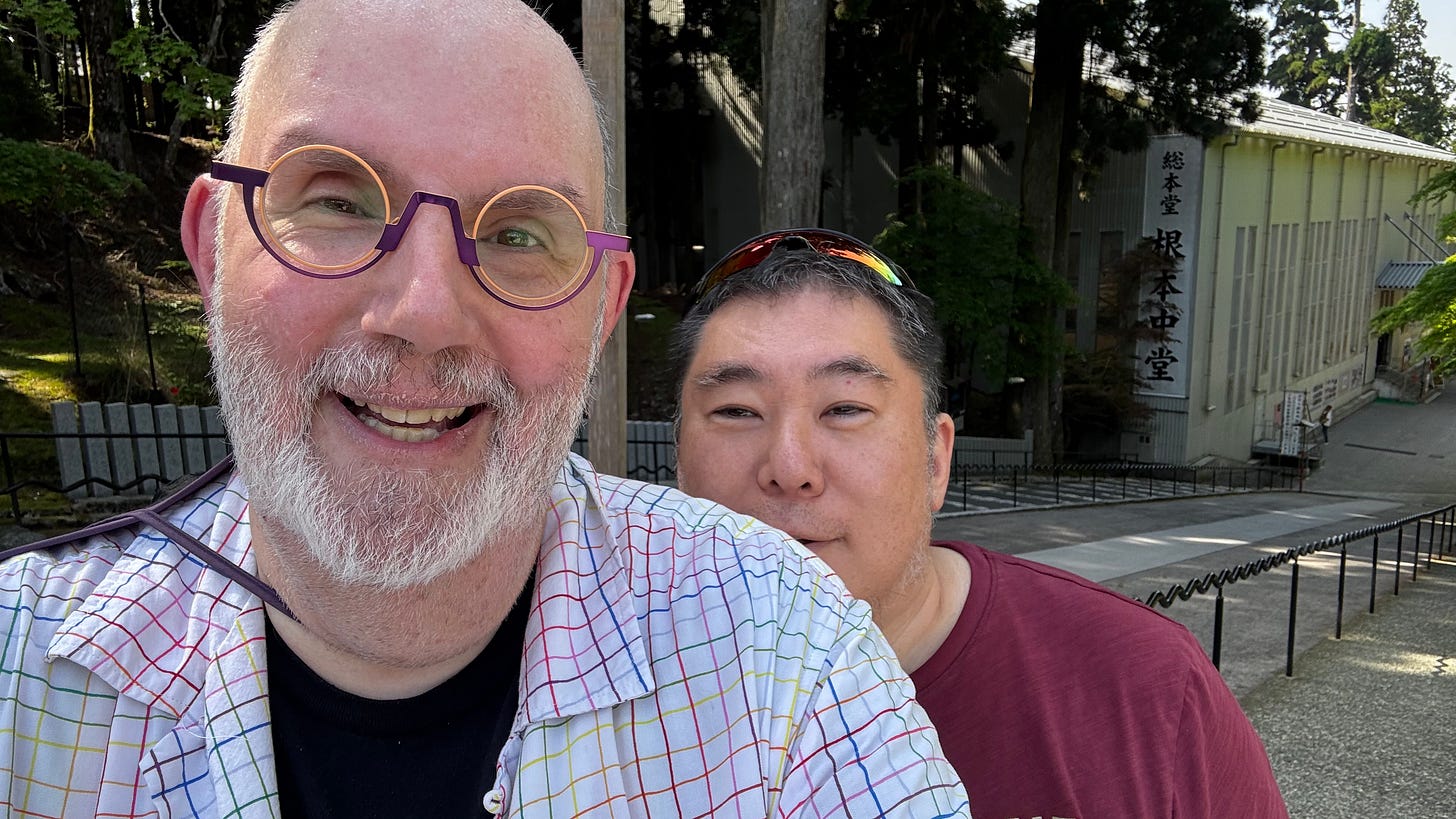Although both Hiro and I consider our first date in November of 1993 to be the more important commemoration, we also celebrate the anniversary of our marriage on 7 July 2013.

Later this month, on 20 July, Japan will hold an election for the House of Councillors, the upper house of its bicameral legislature. Half of the 248 seats are up for grabs. Election victors will earn six-year terms. Ishiba, Japan’s current prime minister and a moderate head of the ironically named Liberal Democratic Party1, needs to maintain a majority to hold onto his leadership.
One of the key issues facing the government, and the issue I have the most interest in, is marriage equality. Japan is the only member of the G7 to not afford marriage equality to its citizens, despite rulings from all five of Japan’s superior courts affirming that lack of equality as unconstitutional2.
Marriage For All Japan, a grassroots movement that has built awareness and support for marriage equality, recently sent four-question questionnaires to each of Japan’s ten national parties3.
What is the party’s position on codifying marriage equality into law?
When will your party involve itself in the effort to codify marriage equality?
Is your party already planning to codify marriage equality?
Is marriage equality within your party’s platform?
Two ultraconservative parties, Sanseitō and the CPJ, declined to answer. The LDP answered in the negative to all four questions, mumbling, as they are in the habit of doing, that more work, including serious deliberation, is needed to advance the public mindset on the partnership systems that multiple prefectural and municipal governments have roled out as well as on different sexualities and gender identities.
All of which is, pardon my French, utter bullshit. Multiple polls indicate that the Japanese people are already well ahead of the LDP in their acceptance of marriage equality. The partnership systems in place at hundreds of local governments across Japan have experienced no negative pushback, but they are a separate-but-not-equal solution.
I’ve railed about this before, but the reason Hiro and I waited nearly twenty years before getting married had less to do with our commitment to one another and more to do with the lack of federal recognition. We needed the Windsor v. United States decision in 2013 because only then could Hiro apply for permanent residency in the United States.
Just as had been true for the civil unions and domestic partnerships that multiple US states had enacted, the local government partnership systems are of no use to the thousands of binational same-sex couples (where one member of that couple is a Japanese citizen) both within Japan and beyond. Without recognition of marriage at the national level, those binational couples are in an endless limbo.
The good news from the Marriage For All Japan questionnaire is that seven of the ten national parties, including the normally conservative Kōmeitō, the LDP’s current coalition partner, are resoundingly in support of marriage equality, are already involved in efforts to codify marriage equality into law, and include marriage equality in their party platforms.
I have frequently joked that among the scales of time—clock time, geological time, astronomical time—Japanese bureaucracy and government time represent the slowest visible changes. But this acceptance of marriage equality has happened in what seems to be a blink of an eye.
Some people credit the 2024 Netflix Japan series, The Boyfriend, with triggering a shift in public attitudes, but I also have to believe that the five high courts that ruled that the lack of marriage equality is unconstitutional have had a more profound effect on lawmakers. The upcoming Japanese Supreme Court ruling, which observers believe will adopt the same stance as the high court rulings, won’t force the government to immediate action, but if the LDP loses its majority after the 20 July elections, a coalition government might indeed be poised to act in favor of queer people throughout Japan.
I would love few things more than for our marriage to finally be recognized in Japan.
Since the Liberal Democratic Party’s inception in the 1950s, encouraged by the United States’ CIA as a bulwark against the increasing post-war popularity of Japan’s Communist Party, the LDP has been staunchly reactionary, even when riddled with scandals.
Japan’s Supreme Court is set to rule on the issue either in late 2025 or early 2026.
First of all, can I just get an amen for the ability to function with ten political parties? Compared to the United States’ system of two parties, the Democrats, increasingly right-wing since the Reagan era, and the far-right Republicans, having ten parties seems like a dream. Those parties, in ideological order, from ultraconservative to progressive, are:
Sanseitō, an ultraconservative party led by a whackadoodle who most recently claimed that gender equality was a mistake
Conservative Party of Japan, ultranationalist, right-wing populism
LDP, conservative
Democratic Party for the People, conservative
Isshin, right-wing populism
Komeitō, a socially conservative party formed by former black marketeer and founder of the Buddhist Soka Gakkai cult, Daisaku Ikeda, has been in an official coalition with the LDP since 2012
Constitutional Democratic Party, liberalism
Reiwa, progressive, left-wing populism
Social Democratic Party, democratic socialism
Japanese Communist Party, democratic socialism
There are also, always, fringe parties in Japan. During my ten years there, for example, a former professional wrestler whose ring name was Antonio Inoki formed the Sports Peace Party. In 2025, the fringiest of the fringe parties is the Anti-NHK Party, created by a guy (it’s always a guy) fed up with the subscription fee requirement for Japan’s public television network, NHK. The said guy is currently campaigning with a red Make America Great Again ball cap on his head. The jokes write themselves, folks.






